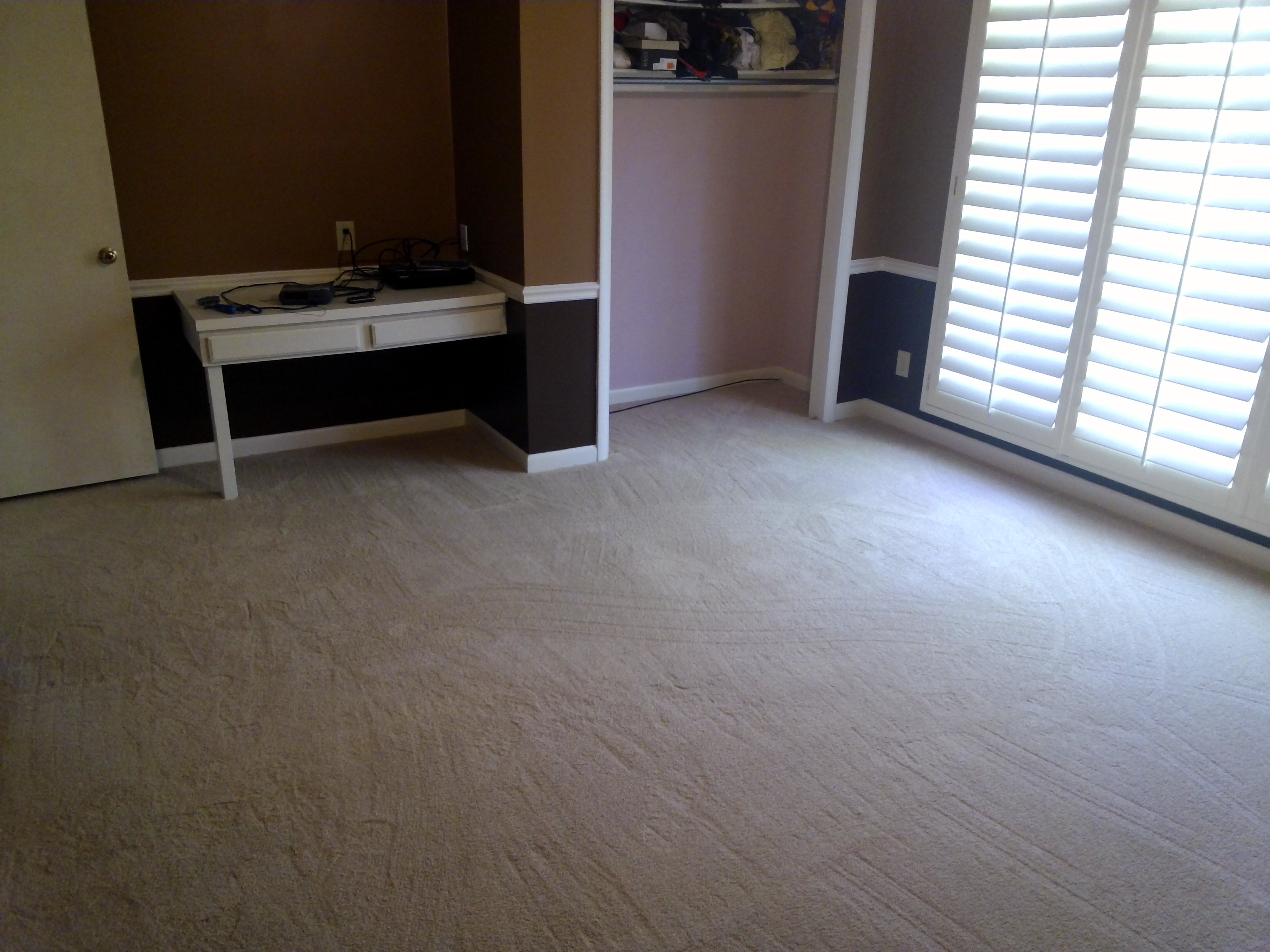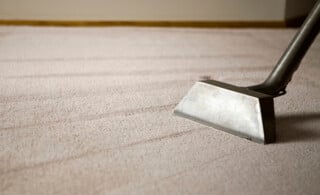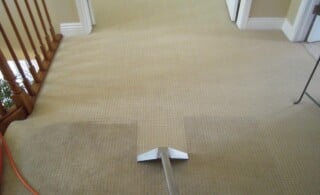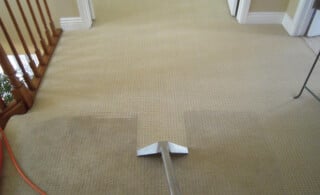
While your carpeting may not require the regular cleaning that other types of flooring demand, your carpet should be professionally cleaned once every year to 18 months, even if you vacuum regularly. Professional carpet cleaning extends the life of the carpeting and contributes to better air quality, reducing allergies and illness.
Do-It-Yourself Carpet-Cleaning Mistakes
Ideally, your carpet should be professionally cleaned. However, to save money, many people alternate between the do-it-yourself cleaning and professional cleaning. While the do-it-yourself approaches are far less expensive, they are almost never as effective as professional cleaning and involve a considerable amount of time and hard work. Depending on the method used, it is also easy for the novice to damage the carpet.
Beware of the three most common ways do-it-yourselfers (and inexperienced pros) damage carpets:
- Over-shampooing
- Over-wetting
- Failing to protect the wet carpet from furniture
Over-shampooing occurs when either too much shampoo is used or the carpet is not adequately rinsed. Both are practically inevitable with some wet do-it-yourself approaches. This is the biggest reason why even hard-core do-it-yourselfers should occasionally use a professional. If they don’t, the build-up of soapy residue can be impossible to clean out, leaving a carpet that is a virtual dirt magnet.
Over-wetting occurs when too much water soaks into the bottom of the carpet. Some backing materials cause the carpet to discolor if they get too wet. Some carpets will shrink, literally tearing themselves up from the floor. If the backing and pad get wet, it is very difficult to dry them, and you run the additional risk of mold and mildew problems.
The final carpet-cleaning hazard is stains caused by furniture coming into contact with wet carpeting. Many kinds of wood furniture will release some of the dyes in their stain if left in contact with a wet surface. Many pieces of furniture have feet that are at least partially metal. The metal can rust, leaving a stain in the carpet.
Do-it-yourselfers are more likely to encounter these problems because they often don’t remove all the furniture from the room when cleaning, and they often don’t have ready access to the foam blocks and foil-backed cardboard squares that the pros use to keep the furniture off the carpet until it is dry.
Ready to start your Carpet Cleaning?
Find ProsProfessional Carpet-Cleaning Methods
One carpet-cleaning method, dry extraction, isn’t technically a “dry” procedure; it’s more a “moisture-controlled” process. That is, it applies a controlled amount of moisture to clean the carpet and still leave it dry. This process is similar to the do-it-yourself “dry” method, but the equipment is larger and much more thorough.
Though it uses the same cleaning chemicals, the dry process alters the amount of chemicals used and how they’re applied. A machine with two counter-revolving brushes moves the cleaning agents through the carpet’s material. The cleaner supplies enough liquid to dissolve the dirt, then re-absorbs the soil and liquid, which leaves the carpet dry for vacuuming and immediate use.
Some carpet-cleaning professionals spray a carbonated cleaning solution onto the carpet. The carbonation allows the cleaning agents to get to the carpet fibers with minimal wetting. The solution doesn’t contain the oil or detergents that typically leave a dirt-attracting residue. Dissolved dirt is removed with a machine that rubs soft cotton pads over the carpet.
When compared to wet systems, some suggest this method may not get as much of the deeper dirt out, but in fact the dry method does get into the fibers and the base of the carpet to clean. It does this without the risks of residue or over-wetting. Many businesses use this system because the carpet is usually dry and ready for traffic within an hour.
Otherwise, professionals use methods similar to do-it-yourself approaches, with two important differences. First, pros do this all day every day, and that experience helps them realize the maximum cleaning potential of each system and avoid the hazards of each.
Second, pros usually use much more powerful and sophisticated equipment and cleaning agents. Because they know what they’re doing, they can use all that extra power without succumbing to the risks that power entails.
For example, on heavily soiled carpet a professional might first use a power shampoo system and then follow it with hot water extraction. There is equipment that does both in one pass. Often, the vacuums used in hot water extraction systems are extremely powerful and are mounted on a truck that is parked in front of the home.
Home cleaning services have two other advantages as well. First, they’re accustomed to moving the heavy furniture. Second, they usually know a lot more about how to handle specific challenges like heavily soiled areas and stains.
Carpet Stains and Carpet-Cleaning Extras
Carpet stain removal: Some firms include stain removal in the base price. Other firms charge extra for highly soiled areas or for individual stains. Ask about this up front.
Carpet pretreatment: Most wet-cleaning results can be improved by spraying a cleaning agent on the carpet a few minutes before cleaning. The chemicals help dissolve grease and oils so that the final cleaning extracts even more dirt. For some firms this is standard procedure; others may charge extra by the square foot or room. Be sure to ask.
Soil retardants: Most carpets are now factory-treated with a coating that helps the carpet fibers shed water and spills. The key is cleaning up the spills quickly. Once a carpet is five years old or so, you may need to have it retreated, at least in the high traffic areas.
The easiest way to check whether carpet retreatment is necessary is to place a few drops of water on the carpet in the questionable areas and see whether the drops bead up or are absorbed quickly into the fibers. If they are absorbed, it’s time to retreat the carpet.
The best retreatment chemicals (and usually the only ones recommended by the manufacturers) are fluorochemical based. Scotchgard or any treatment containing Dupont’s Teflon are made from this material. The treatment should take place after cleaning and, for best results, should be gently brushed into the carpet while it is still damp.
Deodorizing and pet odor treatments: Most of the possible carpet odor reduction that can be accomplished will be accomplished by the cleaning itself. Many odors come from mold, mildew, or urine that has penetrated the carpet backing and pad. There is no practical way to get at the source without damaging the carpet through over-wetting.
Applying an anti-microbial agent (see below) will help slow the return of mildew and mold. Other than that, “deodorizing” is really nothing more than masking the odor with some stronger and more pleasing scent. Carpet perfumes have only a temporary effect and may be irritating to some people.
Anti-microbial treatment: The cleaning itself will kill most mold, mildew, yeast and other microbes, but it is practically impossible to kill all of them. The anti-microbial treatment creates a hostile environment for these microbes to reproduce and spread and will help control odor problems, extend the carpet’s useful life, and provide considerable relief to allergy sufferers.
Anti-static treatment: Static electricity often becomes annoying in the winter, when heating systems dry out the air in our homes. Carpet manufacturers have responded by developing new finishes, fibers, and backings that prevent the build-up of static electricity. If you are having a problem with your carpet, the easiest, best, and healthiest remedy is to increase humidity with a humidifier.
Once the relative humidity gets above about 40 percent, the static problem disappears. There are several treatments and finishes that can be applied that reduce static electricity, but nearly all act as soil magnets, greatly speeding up the rate at which your carpet gets soiled.
 Is Your Carpet Cleaner Good for Your Health and the Environment?
Is Your Carpet Cleaner Good for Your Health and the Environment?  Hot Water Extraction For Your Carpets
Hot Water Extraction For Your Carpets  How to Remove Pet Odor From Your Carpets
How to Remove Pet Odor From Your Carpets  Pros, Cons and Costs: Carpet Cleaning
Pros, Cons and Costs: Carpet Cleaning  Carpet Cleaning Equipment: What to Know Before You Spend
Carpet Cleaning Equipment: What to Know Before You Spend 

I need a synthetic carpet cleaned with areas of deep/ long standing urine stains. Also I have a Persian rug that needs cleaning.
Buy new carpet. Take ur Persian rug to a professional rug cleaner. Not the cheapest. A true Persian is delicate fibers and hand woven
I bought a house yr and half ago with nice clean carpet in my finished basement. Now I have traffic stains from shoes and things like that. I bought a carpet cleaner not knowing that certain carpets have a way of cleaning them solvents etc. Now I don’t know what type of carpet type I have to clean it room right. Any help would be great. Thanks
Can I clean carpet that is laying on cement in my garage Mancave no backing on the carpet just carpet
Yes.
I had a friend to clean my dark green and burgundy carpets. Not only are they not cleaned but left the green room carpet looking lighter but not bleached white. What do I do?
Absolutely phenomenal content as a owner of a small family owned carpet tile upholstery cleaning cleaning service in the Denver metro area this information is 100% spot on. We love to educate and encourage homeowners on industry standards to help them to understand what it is like to have your carpets Tile and Upholstery professionally cleaned by a certified companys that is Certified by the IICRC and are highly recommended because of the knowledge and training it takes to help you protect your biggest investments in your home.
I use pet shampoo for my steam cleaning needs and it has Scotchgard in it. Do I rinse the carpet after I am finished with the shampooing??
We have rubber padding throughout our house, which was highly recommended by our sales “expert” – right. A large area sits on cement, and I fight an “old” smell constantly.
Is there a recommended way to clean the carpet that sits on a rubber pad? Thank you!
Do I have carpet stretched before or after cleaning?
Using too much elbow grease on carpet stains is one of the common mistakes happen while carpet cleaning. For carpet cleaning you have to rely completely on professional carpet cleaning companies to get the best results for your carpets.
Can I shampoo my carpets in the month of December? Or will it cause carpet mites?
Can I use deluted bleach in a carpet cleaner?
Hi. Besides the professional carpet cleaner, I shampoo little areas myself. I normally rinse with little water at a time, but this time I bought “clean and protect with scotchgard” and I would like to know how to handle the rinse. Would the rinse remove the Scotchgard. In that case will I need to go over again with some shampoo? I know that soap attracts dust fast.
Note: when I shampoo i leave less water than the professionals but don’t wash the whole carpet, just where my sick husband drops the cookies and the area where feet stand the most and the walk areas. thank you for your support. I am an old person and used to the old system.
I use my own machine to clean carpet but I feel the return doesn’t pick up enough water into the other tank. Why is this so? I fill one side, therefore shouldn’t I get about the same water back? Please let me know if I’m doing something wrong. Thanks
.